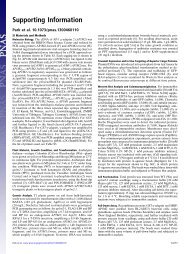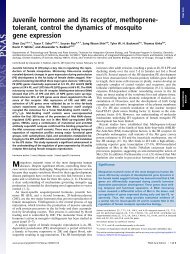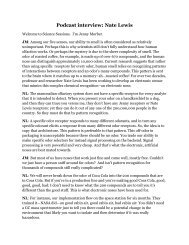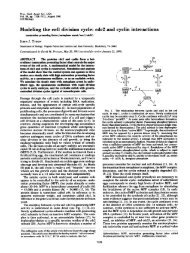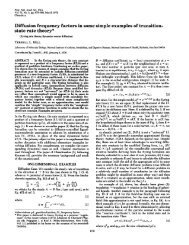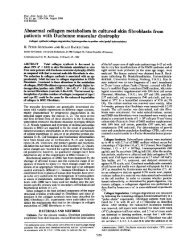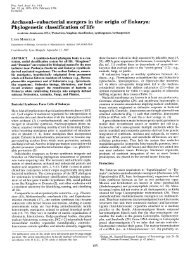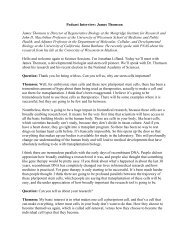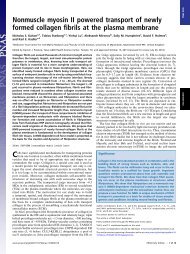Rabbit monoclonal antibodies: Generating a fusion partner to ...
Rabbit monoclonal antibodies: Generating a fusion partner to ...
Rabbit monoclonal antibodies: Generating a fusion partner to ...
You also want an ePaper? Increase the reach of your titles
YUMPU automatically turns print PDFs into web optimized ePapers that Google loves.
Proc. Natl. Acad. Sci. USA<br />
Vol. 92, pp. 9348-9352, September 1995<br />
Immunology<br />
<strong>Rabbit</strong> <strong>monoclonal</strong> <strong>antibodies</strong>: <strong>Generating</strong> a <strong>fusion</strong> <strong>partner</strong> <strong>to</strong><br />
produce rabbit-rabbit hybridomas<br />
(myc/abl/transgenic rabbits/plasmacy<strong>to</strong>ma/B cells)<br />
HELGA SPIEKER-POLET, PERIANNAN SETHUPATHI, PI-CHEN YAM, AND KATHERINE L. KNIGHT*<br />
Department of Microbiology and Immunology, Stritch School of Medicine, Loyola University Chicago, Maywood, IL 60153<br />
Communicated by Alfred Nisonofft Brandeis University, Waltham, MA, June 16, 1995 (received for review April 10, 1995)<br />
ABSTRACT During the last 15 years several labora<strong>to</strong>ries<br />
have attempted <strong>to</strong> generate rabbit <strong>monoclonal</strong> <strong>antibodies</strong>,<br />
mainly because rabbits recognize antigens and epi<strong>to</strong>pes that<br />
are not immunogenic in mice or rats, two species from which<br />
<strong>monoclonal</strong> <strong>antibodies</strong> are usually generated. Monoclonal<br />
<strong>antibodies</strong> from rabbits could not be generated, however,<br />
because a plasmacy<strong>to</strong>ma <strong>fusion</strong> <strong>partner</strong> was not available. To<br />
obtain a rabbit plasmacy<strong>to</strong>ma cell line that could be used as<br />
a <strong>fusion</strong> <strong>partner</strong> we generated transgenic rabbits carrying two<br />
transgenes, c-myc and v-abl. These rabbits developed plasmacy<strong>to</strong>mas,<br />
and we obtained several plasmacy<strong>to</strong>ma cell lines<br />
from which we isolated hypoxanthine/aminopterin/thymidine-sensitive<br />
clones. One of these clones, when fused with<br />
spleen cells of immunized rabbits, produced stable hybridomas<br />
that secreted <strong>antibodies</strong> specific for the immunogen. The<br />
hybridomas can be cloned and propagated in nude mice, and<br />
they can be frozen without change in their ability <strong>to</strong> secrete<br />
specific <strong>monoclonal</strong> <strong>antibodies</strong>. These rabbit-rabbit hybridomas<br />
will be useful not only for production of <strong>monoclonal</strong><br />
<strong>antibodies</strong> but also for studies of immunoglobulin gene rearrangements<br />
and isotype switching.<br />
Monoclonal <strong>antibodies</strong> (mAbs) from rabbits have not been<br />
available because no rabbit plasmacy<strong>to</strong>mas, from which a<br />
hybridoma <strong>fusion</strong> <strong>partner</strong> could be generated, have been<br />
identified. The availability of rabbit mAbs is, however, highly<br />
desirable for several reasons. First, rabbits are known <strong>to</strong><br />
produce <strong>antibodies</strong> <strong>to</strong> many antigens that are not especially<br />
immunogenic in mice (1-5). For example, Bystryn et al. (2)<br />
directly compared rabbit and mouse <strong>antibodies</strong> directed<br />
against human melanoma cells and showed that they recognize<br />
different epi<strong>to</strong>pes. Second, rabbit <strong>antibodies</strong> are generally of<br />
high affinity. Third, because most mAbs are generated in mice<br />
and rats, relatively few mAbs are available that react with<br />
mouse or rat immunogens. Because of this desire for rabbit<br />
mAbs several labora<strong>to</strong>ries developed mouse-rabbit heterohybridomas,<br />
but this technology has had limited success. The<br />
earliest mouse-rabbit heterohybridomas were unstable and/or<br />
secreted only light (L) chain (6-9). Raybould and Takahashi<br />
(5) reportedly overcame this problem by using normal rabbit<br />
serum (NRS) instead of fetal calf serum (FCS) as a supplement<br />
<strong>to</strong> the culture medium. However, Verbanac et al. (10) described<br />
major problems with this method. For example, they<br />
found that the heterohybridomas were highly unstable and had<br />
<strong>to</strong> be subcloned every 4-6 weeks <strong>to</strong> avoid loss of antibody<br />
secretion. In our labora<strong>to</strong>ry, we obtained no more than two <strong>to</strong><br />
five hybridomas per <strong>fusion</strong> when using the method described<br />
by Raybould and Takahashi (5). Further, these heterohybridomas<br />
were difficult <strong>to</strong> clone, and the clones were generally<br />
unstable and did not secrete antibody over a prolonged period<br />
of time. Thus it became clear that heterohybridomas were not<br />
a satisfying solution and that rabbit-rabbit hybridomas were<br />
The publication costs of this article were defrayed in part by page charge<br />
payment. This article must therefore be hereby marked "advertisement" in<br />
accordance with 18 U.S.C. §1734 solely <strong>to</strong> indicate this fact.<br />
I<br />
9348<br />
needed <strong>to</strong> stably produce <strong>monoclonal</strong> rabbit <strong>antibodies</strong>. We<br />
have now developed a <strong>fusion</strong> <strong>partner</strong> from a myc/abl doubletransgenic<br />
rabbit, and we report the successful production of<br />
stable antigen-specific rabbit-rabbit hybridomas.<br />
MATERIALS AND METHODS<br />
Transgenic <strong>Rabbit</strong>s. Single-cell zygotes were injected with a<br />
murine E,,-abl construct [kindly provided by S. Cory (11); E,,<br />
is the immunoglobulin heavy chain enhancer] at a concentration<br />
of 1 ,tg/ml and implanted in<strong>to</strong> the uterus of pseudopregnant<br />
females (12). Offspring were tested at 3-4 weeks of age<br />
by Southern blot analysis of peripheral blood lymphocyte DNA<br />
for the presence of the E,,-abl transgene. <strong>Rabbit</strong>s carrying the<br />
E,,-abl transgene were mated with EK-myc transgenic rabbits<br />
established previously in our labora<strong>to</strong>ry (EK is the K-chain<br />
enhancer) (13). The offspring were tested for the presence of<br />
both transgenes as described above. In addition, we directly<br />
microinjected zygotes from a transgenic EK-myc rabbit with the<br />
EK-abl transgene.<br />
Generation of Plasmacy<strong>to</strong>ma Cell Lines and a Hypoxanthine/Aminopterin/Thymidine<br />
(HAT)-Sensitive Fusion<br />
Partner. <strong>Rabbit</strong>s that became ill were sacrificed and cells from<br />
the tumorous tissues were placed in tissue culture in an attempt<br />
<strong>to</strong> obtain plasmacy<strong>to</strong>ma cell lines. Culture medium used was<br />
RPMI 1640 enriched with the following additions: amino acids,<br />
nonessential amino acids, pyruvate, glutamine, vitamins,<br />
Hepes, gentamicin, penicillin, strep<strong>to</strong>mycin, fungizone (all<br />
components were from GIBCO and were used at concentrations<br />
suggested by the supplier), and 50 ,uM 2-mercap<strong>to</strong>ethanol.<br />
After 6-8 weeks in culture, stable cell lines were growing<br />
from these tumorous tissues.<br />
To obtain a HAT-sensitive <strong>fusion</strong> <strong>partner</strong>, three cell lines<br />
were first x-irradiated with 200 rad (1 rad = 0.01 Gy) and then<br />
cultured in the presence of 8-azaguanine. (The concentration<br />
of 8-azaguanine was initially 0.2 ,ug/ml and was slowly increased<br />
<strong>to</strong> 20 ,ug/ml over a 10-month period.) We obtained<br />
three 8-azaguanine-resistant clones: 20337-7 after one month<br />
and 240E1-1-1 and 240E1-1-2 after 8 months in culture. Cells<br />
of these three clones were sensitive <strong>to</strong> medium containing<br />
HAT.<br />
Fusions. <strong>Rabbit</strong>s received a primary immunization by injection<br />
of antigen (a <strong>to</strong>tal of 2 mg of protein or 2 x 107 cells<br />
per immunization) in complete Freund's adjuvant subcutaneously,<br />
intramuscularly, and intraperi<strong>to</strong>neally. The animals<br />
were boosted once or twice in the same manner but with<br />
incomplete Freund's adjuvant. The final boost was given<br />
intraperi<strong>to</strong>neally and intravenously with saline 4 days before<br />
the <strong>fusion</strong>. Fusions were performed using conventional methodology<br />
(14): spleen cells (1.5-3 x 108) of immunized rabbits<br />
and the <strong>fusion</strong> <strong>partner</strong> 240E 1-1-2 were fused at a ratio of 2:1<br />
Abbreviations: mAb, <strong>monoclonal</strong> antibody; L chain, light chain; NRS,<br />
normal rabbit serum; FCS, fetal calf serum; HAT, hypoxanthine/<br />
aminopterin/thymidine; FITC, fluorescein isothiocyanate.<br />
*To whom reprint requests should be addressed.
Immunology: Spieker-Polet et aL<br />
with 50% PEG 4000 (EM Science, Cherry Hill, NJ 08304) at<br />
37°C in serum-free medium. The cells were plated in 48-well<br />
microtiter plates, at approximately 2 x 105 spleen cells per<br />
well, in medium with 15% FCS. After 72 h, HAT was added.<br />
Medium was changed every 5-6 days. Clones usually were<br />
observed after 2-5 weeks. Supernatants were tested for the<br />
presence of antibody specific for the immunogen, either by<br />
immunofluorescence with Jurkat cells [using fluorescein isothiocyanate<br />
(FITC)-conjugated goat anti-rabbit L-chain antibody<br />
as secondary reagent] (<strong>fusion</strong> 1) or by ELISA (<strong>fusion</strong>s 2<br />
and 3). Hybridomas were cloned by limiting dilution in 48-well<br />
microtiter plates. For feeder cells, we used the <strong>fusion</strong> <strong>partner</strong>,<br />
240E1-1-2, at 5 x 104 cells per well. These feeder cells were<br />
killed 5-6 days later by the addition of HAT.<br />
In preliminary <strong>fusion</strong> experiments we noticed excessive<br />
growth of adherent cells in several wells, which prevented the<br />
hybridomas from establishing themselves. Such growth of<br />
adherent cells, which interferes with the growth of fused cells,<br />
has been reported by other investiga<strong>to</strong>rs (5, 15). The extent of<br />
this growth varied from one experiment <strong>to</strong> another, and it<br />
could be partially prevented if FCS was <strong>to</strong>tally or partly<br />
replaced by NRS. However, the hybridomas appeared <strong>to</strong> grow<br />
more slowly in the absence of FCS. In one experiment, we<br />
attempted <strong>to</strong> remove the adherent cells by incubating the<br />
spleen cell suspension on plastic dishes for 6 h at 37°C before<br />
fusing them. Although this method did not eliminate adherent<br />
cell growth, it did reduce the number of wells with adherent<br />
cells.<br />
ELISA. ELISA (16) was performed in 96-well microtiter<br />
plates (Falcon 3912, Fisher) that were coated overnight with<br />
purified goat anti-rabbit L-chain antibody, 1,g/ml, or with the<br />
immunogen, 2 Ag/ml. The following solutions were added,<br />
sequentially, for 1-2 h at room temperature: first, the supernatant<br />
<strong>to</strong> be tested, then biotinylated goat anti-rabbit L chain<br />
or, when assaying for rabbit immunoglobulin isotypes, biotinylated<br />
goat anti-rabbit g-, y-, or a-chain <strong>antibodies</strong>, 1 jig/ml.<br />
This was followed by incubation with avidin-biotin-horseradish<br />
peroxidase complex (Vectastain ABC Kit, Vec<strong>to</strong>r Labora<strong>to</strong>ries)<br />
and finally with the substrate 2,2'-azinobis(3-ethylbenz<br />
thiazolinesulfonic acid) (ABTS) as suggested by the supplier.<br />
Proc. Natl. Acad. Sci. USA 92 (1995) 9349<br />
Color development was read at 405 nm in an ELISA plate<br />
reader.<br />
RESULTS AND DISCUSSION<br />
Generation of Double-Transgenic <strong>Rabbit</strong>s. Because Rosenbaum<br />
et al. (11) obtained mice with plasmacy<strong>to</strong>mas in myc/abi<br />
double-transgenic mice, we decided <strong>to</strong> generate myc/abl double-transgenic<br />
rabbits in an effort <strong>to</strong> obtain rabbits with<br />
plasmacy<strong>to</strong>ma. A family of transgenic rabbits that carried the<br />
c-myc oncogene linked <strong>to</strong> the K-chain enhancer was developed<br />
previously in our labora<strong>to</strong>ry (13). We now generated a second<br />
family of transgenic rabbits with the v-abl oncogene linked <strong>to</strong><br />
the immunoglobulin heavy chain enhancer (E,,) as a transgene.<br />
A <strong>to</strong>tal of 665 zygotes were microinjected and implanted in 31<br />
pseudopregnant females. From 11 pregnant females we obtained<br />
19 offspring, of which 2 carried the v-abl transgene. To<br />
obtain double-transgenic rabbits we used two methods. In the<br />
first method, EK-myc transgenic rabbits were mated with the<br />
E,,-abl transgenic rabbits. From four matings 22 offspring were<br />
obtained, and of these, 5 carried both transgenes. The plasmacy<strong>to</strong>mas<br />
81E5-1 and 300F1-2 developed in offspring of<br />
transgenic rabbits developed in our labora<strong>to</strong>ry, whereas plasmacy<strong>to</strong>mas<br />
20337-7, 20337-8, and 0022-3 developed in offspring<br />
for which the E,-abl transgenic parent (obtained with<br />
the same E,IL-abl construct) was kindly provided by Andrew<br />
Kelus and Klaus Karjalainen (Basel Institute of Immunology,<br />
Basel, Switzerland). In the second method EK-myc zygotes<br />
were microinjected with E,,-abl DNA. In this case one,<br />
240E1-1, of five offspring carried both transgenes and developed<br />
plasmacy<strong>to</strong>ma. All offspring that carried both transgenes,<br />
c-myc and v-abl, became ill between the ages of 8 and<br />
19 months. Tumors had developed in these rabbits in various<br />
locations. His<strong>to</strong>logic analysis of these tumors revealed that the<br />
rabbits had developed immunoblastic lymphoma or early<br />
plasmacy<strong>to</strong>ma.<br />
Development of a <strong>Rabbit</strong> Fusion Partner. From the tumorous<br />
tissue of five of the six rabbits with plasmacy<strong>to</strong>ma<br />
(300F1-2, 0022-3, 20337-7, 20337-8, and 240E1-1) stable cell<br />
lines were obtained. From these lines, three HAT-sensitive<br />
clones were established by selection with 8-azaguanine and<br />
FIG. 1. <strong>Rabbit</strong> plasmacy<strong>to</strong>ma <strong>fusion</strong> <strong>partner</strong>, 240E1-1-2, stained with Wright-Giemsa stain (Diff-Quick, American Scientific Products, McGaw<br />
Park, IL ). (x1200.)
9350 Immunology: Spieker-Polet et al.<br />
Proc. Natl. Acad. Sci. USA 92 (1995)<br />
Table 1. Frequency and stability of hybridomas obtained in three <strong>fusion</strong>s of the rabbit <strong>fusion</strong> <strong>partner</strong> with spleen cells from<br />
hyperimmunized rabbits<br />
Wells with Hybrids secreting Hybrids yielding<br />
hybrids/wells Hybrids per 106 specific mAb/<strong>to</strong>tal stable clones/<strong>to</strong>tal<br />
Fusion Immunogen plated (%) cells fused hybrids tested (%) hybrids cloned (%)<br />
1 Jurkat cells 200/400(50) 0.7 10/104 (10) ND<br />
2 Ovalbumin 38/980* 0.25 9/36 (25) ND<br />
3 Mouse serum proteins 242/980(25) 1.2 43/187 (23) 7/7 (100)<br />
ND, not determined.<br />
*In many wells adherent cells were growing that prevented the growth of the upcoming hybridomas. In such cases the hybridoma clones had <strong>to</strong><br />
be removed from the adherent cells, and this was done only with 38 clones.<br />
from one of these clones, 240E1-1-2, stable hybridomas could<br />
be obtained. In characterizing this clone, we determined the<br />
doubling time <strong>to</strong> be 48 h, and by staining with Wright-Giemsa<br />
stain (Diff-Quick) we found that the cells had features characteristic<br />
of early plasma cells-i.e., they are large cells with<br />
abundant cy<strong>to</strong>plasm, and the nuclei frequently contain<br />
"lumpy" chromatin. The cells have many vacuoles (Fig. 1),<br />
which indicates that they may be proplasmocytes. These cells<br />
do not secrete immunoglobulin (
Immunology: Spieker-Polet et aL<br />
701<br />
Proc. Natl. Acad. Sci. USA 92 (1995) 9351<br />
C<br />
Control and<br />
Ra anti-<br />
Ms IgG2b<br />
I-~~~~~~~~~~~~~~~~~~~~~~~~~~~~~~<br />
Ju'1<br />
100 101 102 100 101 102 103 100 101 102<br />
Fluorescence intensity<br />
FIG. 3. Immunofluorescence labeling of mouse A20 B-lymphoma cells with <strong>monoclonal</strong> rabbit (Ra) anti-mouse (Ms) IgG2 <strong>antibodies</strong>. A20 cells<br />
were incubated with the supernatants of IgG-secreting rabbit-rabbit hybridomas (<strong>fusion</strong> 3) that were shown by ELISA (Table 2) <strong>to</strong> recognize mouse<br />
IgG2a (clone 53-5) (0.25 ,ug of mAb per ml) (A), IgG2a and IgG2b (clone 80-1) (5 iLg of mAb per ml) (B), or IgG2b (clone 10-6) (0.5 ,ug of mAb<br />
per ml) (C) and none of the other mouse immunoglobulin isotypes. In control samples, A20 cells were incubated with the supernatant of an<br />
IgG-secreting rabbit-rabbit hybridoma that recognizes an irrelevant antigen-i.e., a surface antigen of Jurkat cells (<strong>fusion</strong> 1). As secondary antibody<br />
we used FITC-conjugated goat anti-rabbit L chain.<br />
efficiency for the three <strong>fusion</strong>s performed was between 0.25<br />
and 1.2 in 106 cells, which is comparable <strong>to</strong> the efficiency<br />
generally obtained in mouse-mouse <strong>fusion</strong>s. Of the hybridomas<br />
produced in the three <strong>fusion</strong>s, 10%, 23%, and 25%<br />
secreted mAbs that were specific for the immunogens (Table<br />
1). Again, this percentage of hybridomas that secretes specific<br />
mAb is comparable <strong>to</strong> that obtained in mouse-mouse <strong>fusion</strong>s.<br />
The hybridomas have been subcloned and they were frozen<br />
and thawed without loss in their ability <strong>to</strong> secrete mAb. These<br />
data indicate that the hybridomas are stable and that frequent<br />
cloning, which had been necessary for the heterohybridomas,<br />
is not needed for the rabbit-rabbit hybridomas.<br />
Production of IgA-Secreting Hybridomas. Most of the<br />
hybridomas from spleen secreted IgG and none were found<br />
that secreted IgA (Table 3). Because IgA-producing hybridomas<br />
would be valuable reagents we decided <strong>to</strong> perform<br />
<strong>fusion</strong>s with cells from Peyer's patch (PP) and mesenteric<br />
lymph node (MLN) <strong>to</strong> obtain IgA-secreting hybridomas.<br />
From two separate <strong>fusion</strong>s 34% of the hybridomas from<br />
MLN and 81% of the hybridomas from PP secreted IgA<br />
(Table 3). Similar results were obtained in two additional<br />
experiments-i.e., 35% of the hybridomas from MLN and<br />
38% of the hybridomas from PP secreted IgA. (The other<br />
isotypes were not determined in these experiments.) A high<br />
Table 3. mAbs produced by rabbit hybridomas obtained from<br />
<strong>fusion</strong>s of 240E1-1-2 with mesenteric lymph node (MLN), Peyer's<br />
patch (PP), or spleen cells<br />
No. of clones (% of <strong>to</strong>tal clones)<br />
Cells fused Total IgG IgM IgA<br />
Spleen* 25 25 (100) 0 0<br />
MLNt 82 14 (17) 34 (41) 28 (34)<br />
ppI 48 2 (4) 2 (4) 39 (81)<br />
*Data from <strong>fusion</strong> 3, Table 1: 25 of 43 specific mAbs were analyzed.<br />
tMLN cells of an unimmunized rabbit were activated by murine<br />
CD40-ligand-transfected CHO cells (generously provided by Melanie<br />
Spriggs, Immunex Research and Development Corp., Seattle) for 48<br />
h prior <strong>to</strong> <strong>fusion</strong>. The fused cells were plated in 1000 wells.<br />
tPP cells were treated as described above for MLN cells and plated in<br />
400 wells.<br />
percentage of IgA-producing hybridomas from MLN, PP,<br />
and other mucosal tissues had been found by other investiga<strong>to</strong>rs<br />
for rat (15, 17, 18). In contrast, <strong>fusion</strong> with spleen cells<br />
does not generally yield IgA-secreting hybridomas in either<br />
mice or rats, as we now report for rabbits.<br />
Concluding Statement. The research described here, detailing<br />
our search for a rabbit <strong>fusion</strong> <strong>partner</strong>, began in the<br />
late 1970s, before transgene technology was available. Once<br />
investiga<strong>to</strong>rs showed that lymphoid tumors developed in<br />
transgenic mice carrying various oncogenes (11, 19), we used<br />
this technology <strong>to</strong> develop rabbit plasmacy<strong>to</strong>mas. Our breakthrough<br />
came in 1991 when we found that the myc/abl<br />
double-transgenic rabbits developed plasmacy<strong>to</strong>mas. Since<br />
then, we have established plasmacy<strong>to</strong>ma cell lines and were<br />
able <strong>to</strong> develop one in<strong>to</strong> a usable <strong>fusion</strong> <strong>partner</strong>. The<br />
availability of a rabbit <strong>fusion</strong> <strong>partner</strong> provides us with the<br />
opportunity <strong>to</strong> produce mAbs specific for mouse antigens<br />
and also for antigens or epi<strong>to</strong>pes that are not immunogenic<br />
in mice. Such mAbs will be useful in diagnosis of diseases and<br />
treatment of patients.<br />
This work was supported by Public Health Service Grant Al 11234.<br />
1. Krause, R. M. (1970) Adv. Immunol. 12, 12-29.<br />
2. Bystryn, J., Jacobsen, S. J., Liu, P. & Heaney-Kieras, J. (1982)<br />
Hybridoma 1, 465-472.<br />
3. Weller, A., Meek, J. & Adamson, E. D. (1987) Development<br />
(Cambridge, U.K) 100, 351-363.<br />
4. Norrby, E., Mufson, M. A., Alexander, H., Hough<strong>to</strong>n, R. A. &<br />
Lerner, R.-A. (1987) Proc. Natl. Acad. Sci. USA 84, 6572-6576.<br />
5. Raybould, T. J. G. & Takahashi, M. (1988) Science 240,1788-1790.<br />
6. Yarmush, M. L., Gates, F. T., III, Weisfogel, D. R. & Kindt, T. J.<br />
(1980) Proc. Natl. Acad. Sci. USA 77, 2899-2903.<br />
7. Yarmush, M. L., Gates, F. T., III, Dreher, K. L. & Kindt, T. J.<br />
(1981) J. Immunol. 126, 2240-2244.<br />
8. Dreher, K. L., Sogn, J. A., Gates, F. T., III, Kuo, M. & Kindt, T. J.<br />
(1983) J. ImmunoL 130, 442-448.<br />
9. Kuo, M., Sogn, J. A., Max, E. E. & Kindt, T. J. (1985) Mol.<br />
Immunol. 22, 351-359.<br />
10. Verbanac, K M., Gross, U. M., Rebella<strong>to</strong>, L. M. & Thomas,<br />
J. M. (1993) Hybridoma 12, 285-295.<br />
11. Rosenbaum, H., Harris, A. W., Bath, M. L., McNeall, J., Webb,<br />
E., Adams, J. M. & Cory, S. (1990) EMBO J. 9, 897-905.
9352 Immunology: Spieker-Polet et al.<br />
12. Knight, K L., Spieker-Polet, H., Kazdin, D. S. & Oi, V. T. (1988)<br />
Proc. Natl. Acad. Sci. USA 85, 3130-3134.<br />
13. Sethupathi, P., Spieker-Polet, H., Polet, H., Yam, P., Tunyaplin,<br />
C. & Knight, K. L. (1994) Leukemia 8, 2144-2155.<br />
14. Mishell, B. B. & Shiigi, S. M. (1980) Selected Methods in Cellular<br />
Immunology (W.H. Freeman, San Francisco), pp. 354-367.<br />
15. Oudghiri, M., Seguin, J. & Deslauriers, N. (1987)Adv. Exp. Med.<br />
Biol. 216B, 1215-1222.<br />
Proc. Natl. Acad. Sci. USA 92 (1995)<br />
16. Goding, J. W. (1986) MonoclonalAntibodies: Principles and Practice<br />
(Academic, NY), pp. 82-85.<br />
17. Komisar, J. L., Fuhrman, J. A. & Cebra, J. J. (1982) J. Immunol.<br />
128, 2376-2378.<br />
18. Peppard, J. V. & Jackson, L. E. (1987)Adv. Exp. Med. Biol. 216B,<br />
1207-1213.<br />
19. Stewart, T., Pattengale, P. K. & Leder, P. (1984) Cell 38,<br />
627-637.



